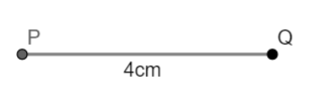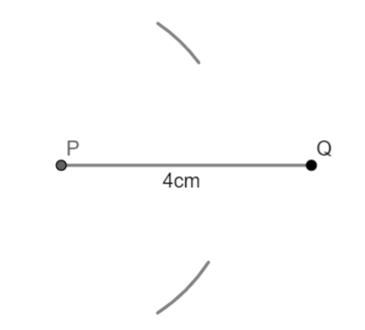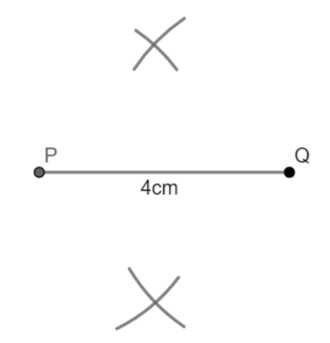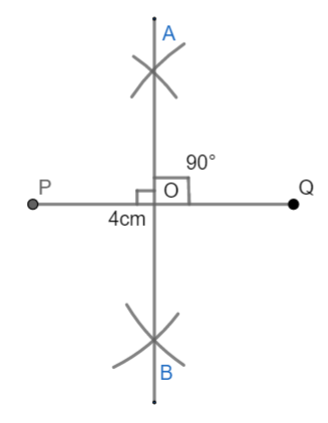
Answer
448.8k+ views
Hint: In this question, we need to construct a perpendicular bisector of the line PQ. For this, we will need a compass and ruler. First we will draw a line segment PQ = 4cm and then use the compass to draw arcs from both ends to both sides of the line. Then we will join points formed to get the perpendicular bisector. We will draw a perpendicular bisector step by step with written steps of construction.
Complete step-by-step answer:
Here, we need to draw a perpendicular bisector of the line PQ. Since PQ is given as 4cm. So following are the steps of construction involved in making a perpendicular bisector.
(i) Draw a line segment PQ = 4cm.

(ii) Now, open the compass more than half the length of the side PQ. With P as center and radius equal than half of PQ, draw an arc on both sides of PQ.

(iii) Now with Q as center and same radius as taken in 2, draw arcs on both sides of PQ. Let these arcs intersect each other at point A and B.

(iv) Join A and B. The line AB cuts the line segment PQ at the point O.

Here, OP = OQ and $\angle AOQ={{90}^{\circ }}$. Thus the line AB is a perpendicular bisector of AB.
Note: Students should note that the perpendicular bisector of any line is a line which cuts the line segments into two equal parts and is perpendicular to the line segment. While drawing arcs, make sure that the compass is opened more than half of PQ otherwise arcs will not cut. Students should check the final diagram seeing if OP = OQ and $\angle AOQ={{90}^{\circ }}$.
Complete step-by-step answer:
Here, we need to draw a perpendicular bisector of the line PQ. Since PQ is given as 4cm. So following are the steps of construction involved in making a perpendicular bisector.
(i) Draw a line segment PQ = 4cm.

(ii) Now, open the compass more than half the length of the side PQ. With P as center and radius equal than half of PQ, draw an arc on both sides of PQ.

(iii) Now with Q as center and same radius as taken in 2, draw arcs on both sides of PQ. Let these arcs intersect each other at point A and B.

(iv) Join A and B. The line AB cuts the line segment PQ at the point O.

Here, OP = OQ and $\angle AOQ={{90}^{\circ }}$. Thus the line AB is a perpendicular bisector of AB.
Note: Students should note that the perpendicular bisector of any line is a line which cuts the line segments into two equal parts and is perpendicular to the line segment. While drawing arcs, make sure that the compass is opened more than half of PQ otherwise arcs will not cut. Students should check the final diagram seeing if OP = OQ and $\angle AOQ={{90}^{\circ }}$.
Recently Updated Pages
The radius of curvature of a plane mirror is a positive class 10 physics CBSE

Choose the word which is closest to the opposite in class 10 english CBSE

Select the antonym for the following word from the class 10 english CBSE

Select the synonym for the given word Transparency class 10 english CBSE

Select the given word which means the opposite of the class 10 english CBSE

The purest form of carbon is a Graphite b Diamond c class 10 chemistry CBSE

Trending doubts
How do you graph the function fx 4x class 9 maths CBSE

Which are the Top 10 Largest Countries of the World?

Fill the blanks with the suitable prepositions 1 The class 9 english CBSE

What is the meaning of sol in chemistry class 11 chemistry CBSE

The Equation xxx + 2 is Satisfied when x is Equal to Class 10 Maths

The capital of British India was transferred from Calcutta class 10 social science CBSE

Why is there a time difference of about 5 hours between class 10 social science CBSE

Capital of the Cheras was A Madurai B Muziri C Uraiyur class 10 social science CBSE

What organs are located on the left side of your body class 11 biology CBSE




